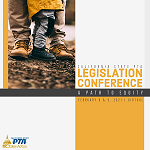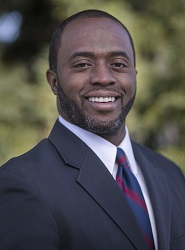This article was written by Kitty Cahalan, President of Blair School PTSA in Pasadena (First District)
 “A Path to Equity” was the focus of this year’s Legislation Conference, which I attended as a local PTA leader and advocate, but also as the parent of two public high school students. Bringing equity to California public schools has long challenged our educational leaders, and the pandemic has highlighted vast inequities in the system and left millions of California students more disadvantaged than ever. From access to mental health care and meals to the widening of a vast digital divide, the conference underscored that the prospect of getting students back on track is daunting. Far from being pessimistic, however, the conference presented information and opportunities that we as parents and PTA advocates can use to disrupt ineffective old practices and bring public education into a new era in which all are included and empowered, and in which the needs of all are seen and addressed.
“A Path to Equity” was the focus of this year’s Legislation Conference, which I attended as a local PTA leader and advocate, but also as the parent of two public high school students. Bringing equity to California public schools has long challenged our educational leaders, and the pandemic has highlighted vast inequities in the system and left millions of California students more disadvantaged than ever. From access to mental health care and meals to the widening of a vast digital divide, the conference underscored that the prospect of getting students back on track is daunting. Far from being pessimistic, however, the conference presented information and opportunities that we as parents and PTA advocates can use to disrupt ineffective old practices and bring public education into a new era in which all are included and empowered, and in which the needs of all are seen and addressed.
 State Superintendent Tony Thurmond opened the conference and focused on restorative justice and increased digital access and literacy as examples of measures needed at the state level to increase inclusiveness and access for all students. President Celia Jaffe shared CAPTA’s ten recommendations for the timely and safe reopening of schools. Director of Legislation Shereen Walter shared CAPTA’s legislative agenda and the critical need for “our collective voices to influence legislation and the state budget to improve equity, access, and opportunity for all of California’s children.” Then, National PTA President-Elect Anna King shared her personal stories of witnessing how racial and economic inequities affected her own children, injustices which led directly to her involvement in PTA and her work to bring a collective voice on behalf of all children to our nation’s leaders and educational decision-makers. This was a powerful start to the conference.
State Superintendent Tony Thurmond opened the conference and focused on restorative justice and increased digital access and literacy as examples of measures needed at the state level to increase inclusiveness and access for all students. President Celia Jaffe shared CAPTA’s ten recommendations for the timely and safe reopening of schools. Director of Legislation Shereen Walter shared CAPTA’s legislative agenda and the critical need for “our collective voices to influence legislation and the state budget to improve equity, access, and opportunity for all of California’s children.” Then, National PTA President-Elect Anna King shared her personal stories of witnessing how racial and economic inequities affected her own children, injustices which led directly to her involvement in PTA and her work to bring a collective voice on behalf of all children to our nation’s leaders and educational decision-makers. This was a powerful start to the conference.
Equity best practices were discussed in sessions about equity in the arts, community schools, and schools as incubators for democracy.
- Tom DeCaigny, California Alliance for Arts Education, stated that even though the arts are shown to be effective for development of motor skills, a powerful educational tool for students with disabilities, and are mandated by the state, arts education implementation continues to fall short in districts throughout the state. DeCaigny identified PTA as a key messenger and urged coordinated messaging for the arts, especially during remote learning.
- Michael Essien, a middle school principal, shared how adherence to the school’s North Stars – whole child, student voice, belonging and rigorous education – combined with ongoing staff training in implicit bias, as well as community partners to bring tiered interventions to students, helped the school meet students and their families where they are. When students feel healthy, safe, and included, he said, they will be ready to learn.
- John Rogers, UCLA’s Institute for Democracy, Education, and Access (IDEA) examined mission statements and LCAPs from districts across the state, looking for indicators that districts consider themselves responsible for the civic education of their students, and found very few districts include keywords such as “democracy” and “civic participation.” Rogers encouraged participants to consider their school districts’ role in furthering democracy and to encourage students to learn how to participate in their communities’ civic lives.
Each of these speakers gave clear, actionable information for the advocates in attendance to use to further the call for equity.
The news on the budget front was encouraging, as California has an unexpected budget surplus. Budget experts discussed the state government’s priorities: addressing the digital divide, helping students who have been the most affected by the pandemic catch up, and providing for an increase in mental health services. Many of these allocations will come in the form of one-time funds and will challenge districts to rapidly deploy services to our most at-risk students. Assembly Speaker Anthony Rendon, pushing for the additional revenue to go to education, especially early childhood education. He said that PTA is best positioned among all advocacy groups to disrupt the layers of abstraction between what is decided in Sacramento and what is happening on school campuses. He challenged us to communicate specifically what is needed in schools. Brooks Allen, Education Policy Advisor to the Governor, made clear the breadth of the challenge – nearly two-thirds of the state’s students, about 3.7 million children, come from economically disadvantaged homes – and the state must focus on these students or the additional funds will not have the impact we wish to see.
The theme of equity echoed throughout the conference: access, inclusive approaches, and listening to all the voices in our communities. Our path toward equity requires that our local and state leaders share a coherent, unified message that puts the needs of the most vulnerable first. Not only was this message shared in multiple legislative meetings, but PTA participants left the conference with the tools to continue to forge this path forward for our students.
To return to the blog homepage, click here.